Equity Mrkts/Debt Instrmnt Mgt: Unilever Financial Analysis Report
VerifiedAdded on 2022/01/17
|20
|3536
|69
Report
AI Summary
This report provides a comprehensive financial analysis of Unilever, a leading fast-moving consumer goods company. The analysis covers the period from 2012 to 2014 and examines key financial aspects, including cash flow, revenue, and various financial ratios such as current ratio, quick ratio, account receivable turnover, inventory turnover, debt to equity/asset ratio, book value per share, gross profit margin, and net profit margin. The report delves into Unilever's financial goals, commitments, and operational strategies across different regions and product segments. It evaluates Unilever's financial performance, highlighting trends in revenue, cash flow, and profitability, and assessing the company's liquidity, solvency, and efficiency. The analysis also includes an examination of Unilever's market share and competitive landscape. The report concludes with a discussion of the company's financial health and provides recommendations regarding investment in Unilever shares. The data used for the analysis is sourced from Unilever's annual reports and market data websites.
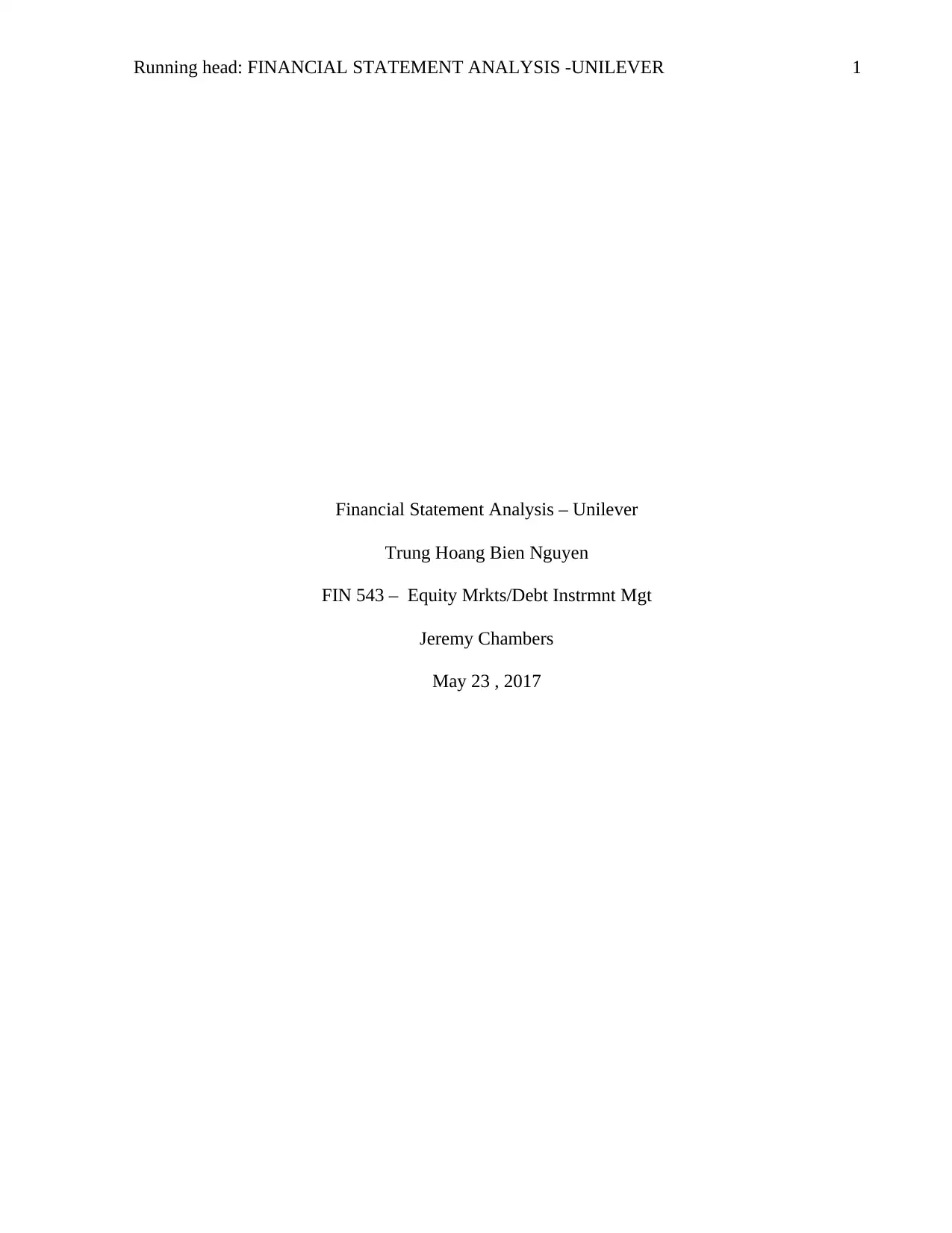
Running head: FINANCIAL STATEMENT ANALYSIS -UNILEVER 1
Financial Statement Analysis – Unilever
Trung Hoang Bien Nguyen
FIN 543 – Equity Mrkts/Debt Instrmnt Mgt
Jeremy Chambers
May 23 , 2017
Financial Statement Analysis – Unilever
Trung Hoang Bien Nguyen
FIN 543 – Equity Mrkts/Debt Instrmnt Mgt
Jeremy Chambers
May 23 , 2017
Paraphrase This Document
Need a fresh take? Get an instant paraphrase of this document with our AI Paraphraser
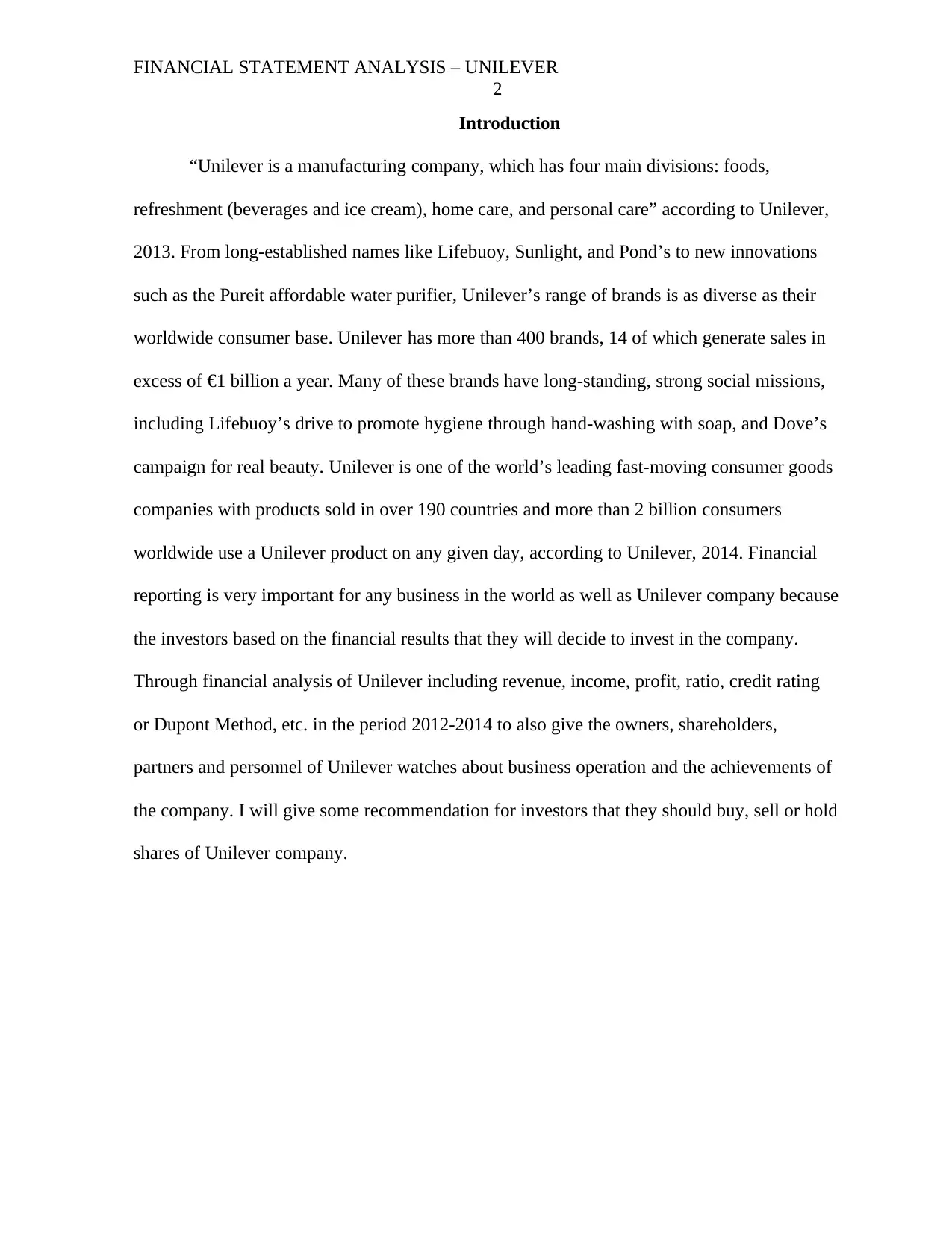
FINANCIAL STATEMENT ANALYSIS – UNILEVER
2
Introduction
“Unilever is a manufacturing company, which has four main divisions: foods,
refreshment (beverages and ice cream), home care, and personal care” according to Unilever,
2013. From long-established names like Lifebuoy, Sunlight, and Pond’s to new innovations
such as the Pureit affordable water purifier, Unilever’s range of brands is as diverse as their
worldwide consumer base. Unilever has more than 400 brands, 14 of which generate sales in
excess of €1 billion a year. Many of these brands have long-standing, strong social missions,
including Lifebuoy’s drive to promote hygiene through hand-washing with soap, and Dove’s
campaign for real beauty. Unilever is one of the world’s leading fast-moving consumer goods
companies with products sold in over 190 countries and more than 2 billion consumers
worldwide use a Unilever product on any given day, according to Unilever, 2014. Financial
reporting is very important for any business in the world as well as Unilever company because
the investors based on the financial results that they will decide to invest in the company.
Through financial analysis of Unilever including revenue, income, profit, ratio, credit rating
or Dupont Method, etc. in the period 2012-2014 to also give the owners, shareholders,
partners and personnel of Unilever watches about business operation and the achievements of
the company. I will give some recommendation for investors that they should buy, sell or hold
shares of Unilever company.
2
Introduction
“Unilever is a manufacturing company, which has four main divisions: foods,
refreshment (beverages and ice cream), home care, and personal care” according to Unilever,
2013. From long-established names like Lifebuoy, Sunlight, and Pond’s to new innovations
such as the Pureit affordable water purifier, Unilever’s range of brands is as diverse as their
worldwide consumer base. Unilever has more than 400 brands, 14 of which generate sales in
excess of €1 billion a year. Many of these brands have long-standing, strong social missions,
including Lifebuoy’s drive to promote hygiene through hand-washing with soap, and Dove’s
campaign for real beauty. Unilever is one of the world’s leading fast-moving consumer goods
companies with products sold in over 190 countries and more than 2 billion consumers
worldwide use a Unilever product on any given day, according to Unilever, 2014. Financial
reporting is very important for any business in the world as well as Unilever company because
the investors based on the financial results that they will decide to invest in the company.
Through financial analysis of Unilever including revenue, income, profit, ratio, credit rating
or Dupont Method, etc. in the period 2012-2014 to also give the owners, shareholders,
partners and personnel of Unilever watches about business operation and the achievements of
the company. I will give some recommendation for investors that they should buy, sell or hold
shares of Unilever company.
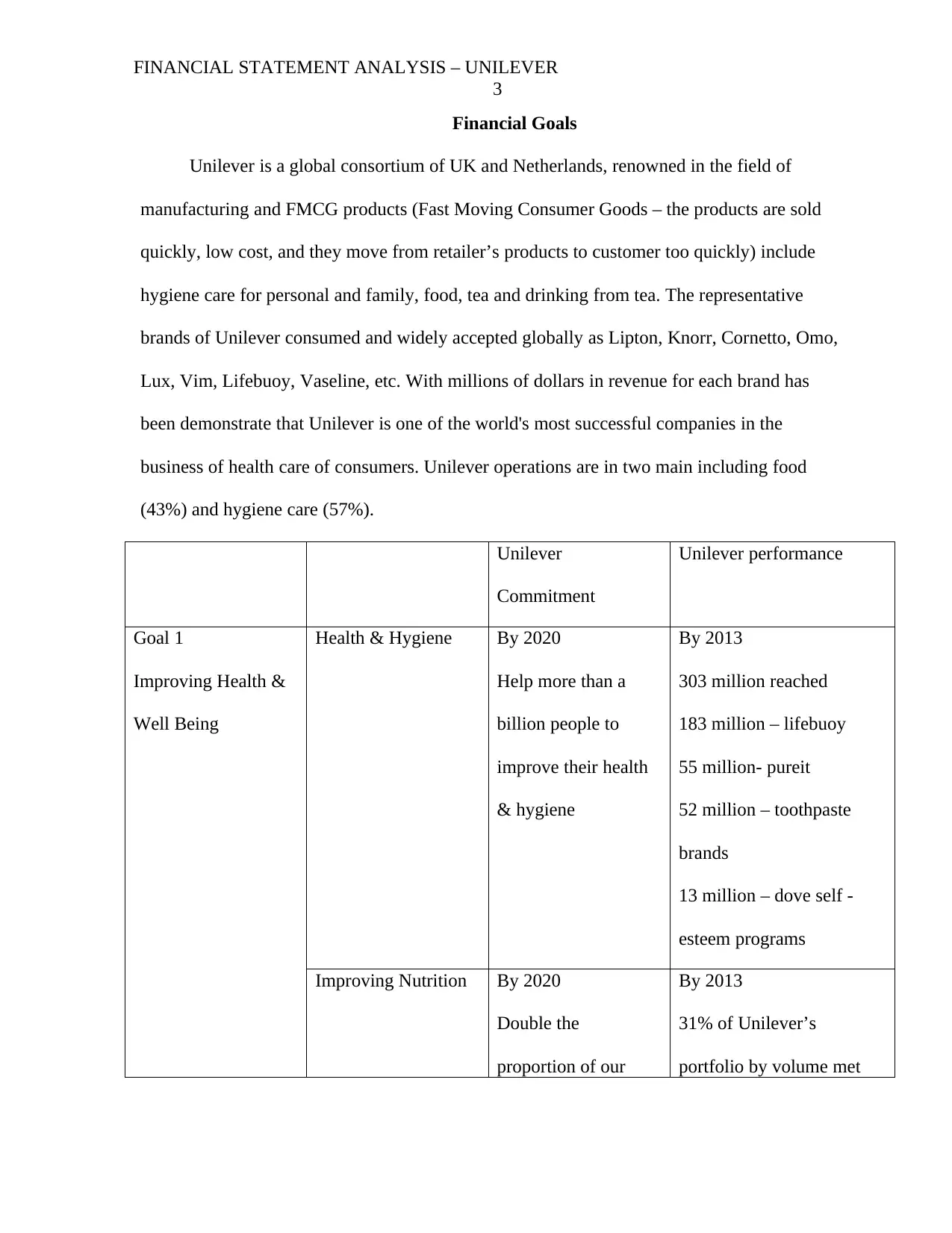
FINANCIAL STATEMENT ANALYSIS – UNILEVER
3
Financial Goals
Unilever is a global consortium of UK and Netherlands, renowned in the field of
manufacturing and FMCG products (Fast Moving Consumer Goods – the products are sold
quickly, low cost, and they move from retailer’s products to customer too quickly) include
hygiene care for personal and family, food, tea and drinking from tea. The representative
brands of Unilever consumed and widely accepted globally as Lipton, Knorr, Cornetto, Omo,
Lux, Vim, Lifebuoy, Vaseline, etc. With millions of dollars in revenue for each brand has
been demonstrate that Unilever is one of the world's most successful companies in the
business of health care of consumers. Unilever operations are in two main including food
(43%) and hygiene care (57%).
Unilever
Commitment
Unilever performance
Goal 1
Improving Health &
Well Being
Health & Hygiene By 2020
Help more than a
billion people to
improve their health
& hygiene
By 2013
303 million reached
183 million – lifebuoy
55 million- pureit
52 million – toothpaste
brands
13 million – dove self -
esteem programs
Improving Nutrition By 2020
Double the
proportion of our
By 2013
31% of Unilever’s
portfolio by volume met
3
Financial Goals
Unilever is a global consortium of UK and Netherlands, renowned in the field of
manufacturing and FMCG products (Fast Moving Consumer Goods – the products are sold
quickly, low cost, and they move from retailer’s products to customer too quickly) include
hygiene care for personal and family, food, tea and drinking from tea. The representative
brands of Unilever consumed and widely accepted globally as Lipton, Knorr, Cornetto, Omo,
Lux, Vim, Lifebuoy, Vaseline, etc. With millions of dollars in revenue for each brand has
been demonstrate that Unilever is one of the world's most successful companies in the
business of health care of consumers. Unilever operations are in two main including food
(43%) and hygiene care (57%).
Unilever
Commitment
Unilever performance
Goal 1
Improving Health &
Well Being
Health & Hygiene By 2020
Help more than a
billion people to
improve their health
& hygiene
By 2013
303 million reached
183 million – lifebuoy
55 million- pureit
52 million – toothpaste
brands
13 million – dove self -
esteem programs
Improving Nutrition By 2020
Double the
proportion of our
By 2013
31% of Unilever’s
portfolio by volume met
⊘ This is a preview!⊘
Do you want full access?
Subscribe today to unlock all pages.

Trusted by 1+ million students worldwide
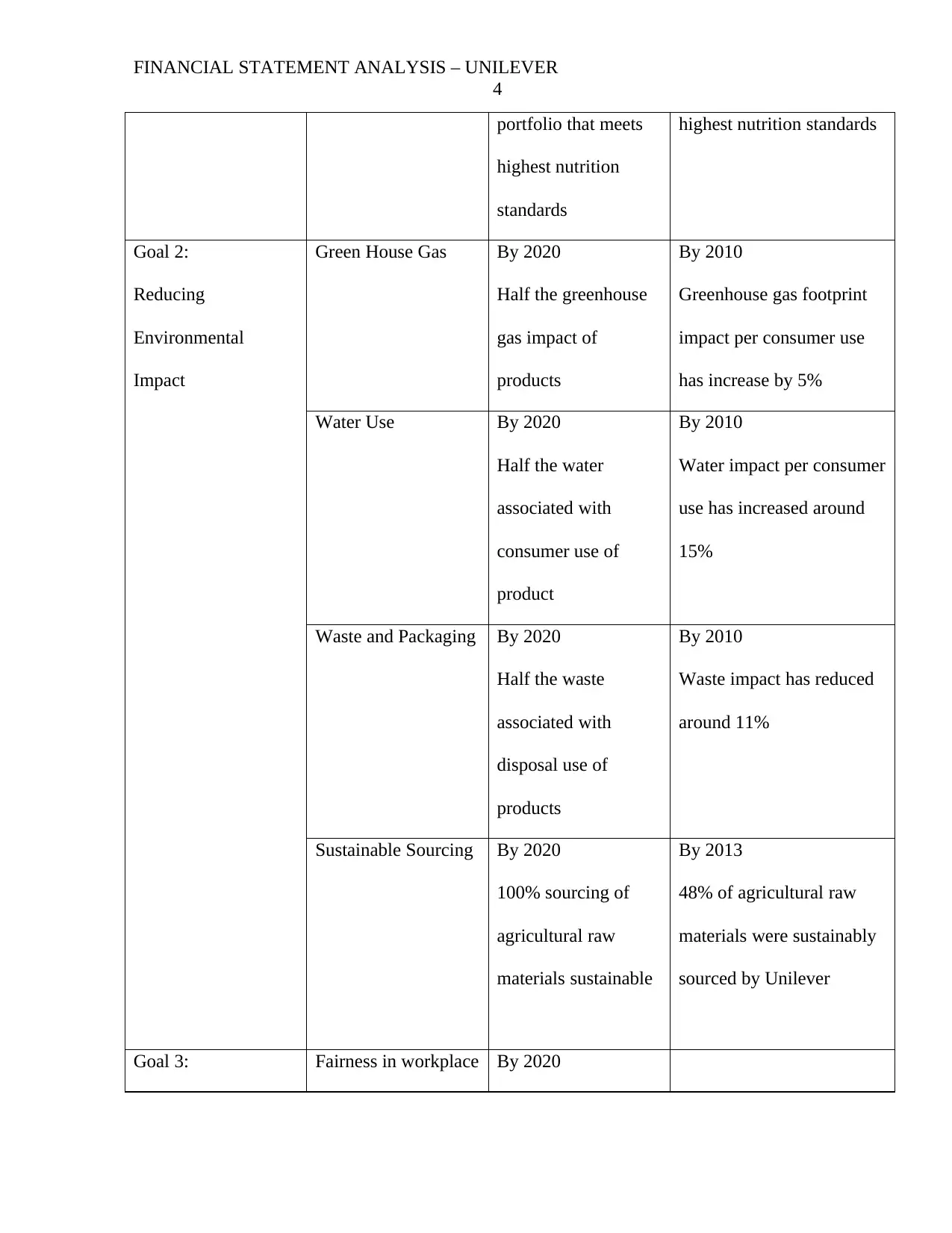
FINANCIAL STATEMENT ANALYSIS – UNILEVER
4
portfolio that meets
highest nutrition
standards
highest nutrition standards
Goal 2:
Reducing
Environmental
Impact
Green House Gas By 2020
Half the greenhouse
gas impact of
products
By 2010
Greenhouse gas footprint
impact per consumer use
has increase by 5%
Water Use By 2020
Half the water
associated with
consumer use of
product
By 2010
Water impact per consumer
use has increased around
15%
Waste and Packaging By 2020
Half the waste
associated with
disposal use of
products
By 2010
Waste impact has reduced
around 11%
Sustainable Sourcing By 2020
100% sourcing of
agricultural raw
materials sustainable
By 2013
48% of agricultural raw
materials were sustainably
sourced by Unilever
Goal 3: Fairness in workplace By 2020
4
portfolio that meets
highest nutrition
standards
highest nutrition standards
Goal 2:
Reducing
Environmental
Impact
Green House Gas By 2020
Half the greenhouse
gas impact of
products
By 2010
Greenhouse gas footprint
impact per consumer use
has increase by 5%
Water Use By 2020
Half the water
associated with
consumer use of
product
By 2010
Water impact per consumer
use has increased around
15%
Waste and Packaging By 2020
Half the waste
associated with
disposal use of
products
By 2010
Waste impact has reduced
around 11%
Sustainable Sourcing By 2020
100% sourcing of
agricultural raw
materials sustainable
By 2013
48% of agricultural raw
materials were sustainably
sourced by Unilever
Goal 3: Fairness in workplace By 2020
Paraphrase This Document
Need a fresh take? Get an instant paraphrase of this document with our AI Paraphraser
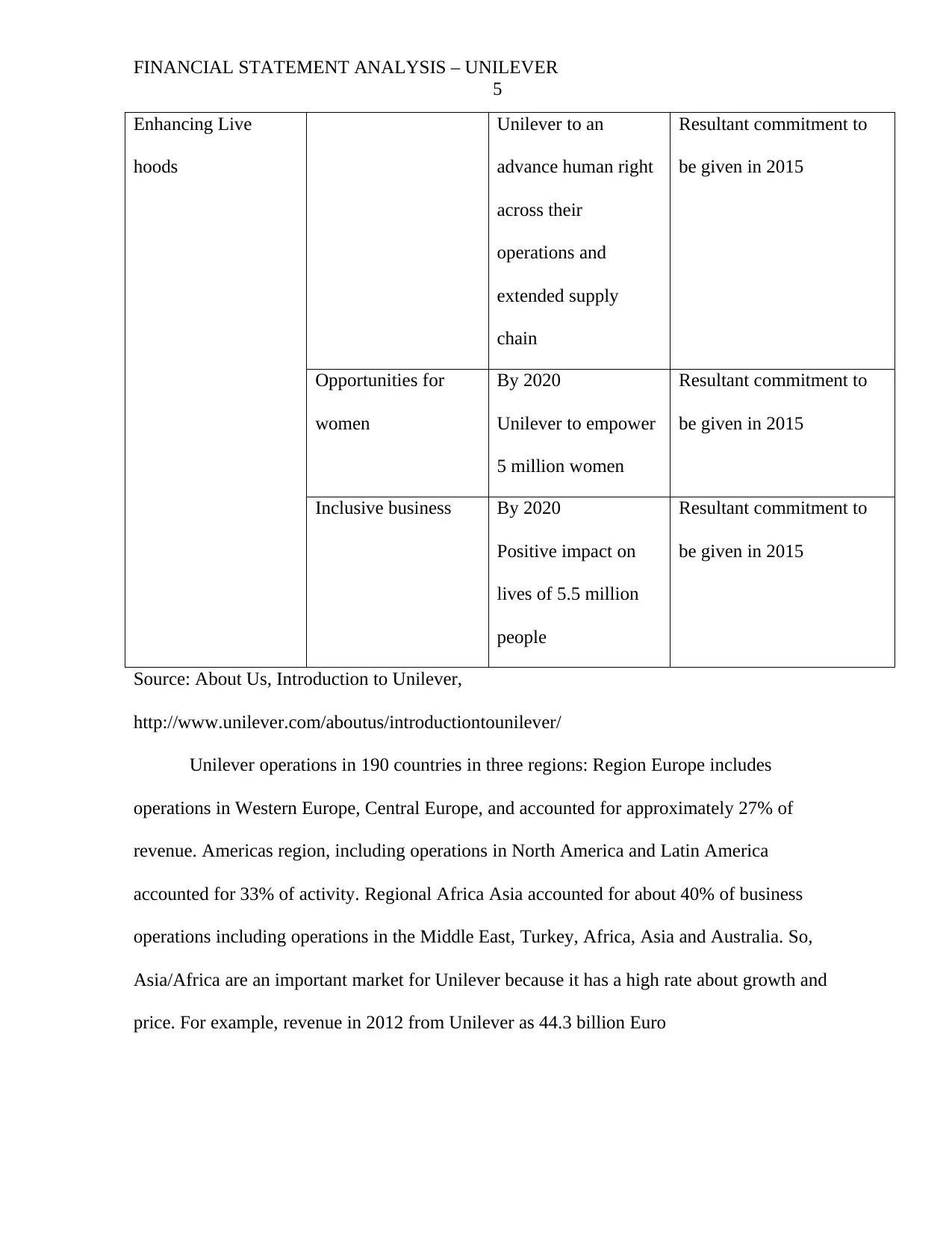
FINANCIAL STATEMENT ANALYSIS – UNILEVER
5
Enhancing Live
hoods
Unilever to an
advance human right
across their
operations and
extended supply
chain
Resultant commitment to
be given in 2015
Opportunities for
women
By 2020
Unilever to empower
5 million women
Resultant commitment to
be given in 2015
Inclusive business By 2020
Positive impact on
lives of 5.5 million
people
Resultant commitment to
be given in 2015
Source: About Us, Introduction to Unilever,
http://www.unilever.com/aboutus/introductiontounilever/
Unilever operations in 190 countries in three regions: Region Europe includes
operations in Western Europe, Central Europe, and accounted for approximately 27% of
revenue. Americas region, including operations in North America and Latin America
accounted for 33% of activity. Regional Africa Asia accounted for about 40% of business
operations including operations in the Middle East, Turkey, Africa, Asia and Australia. So,
Asia/Africa are an important market for Unilever because it has a high rate about growth and
price. For example, revenue in 2012 from Unilever as 44.3 billion Euro
5
Enhancing Live
hoods
Unilever to an
advance human right
across their
operations and
extended supply
chain
Resultant commitment to
be given in 2015
Opportunities for
women
By 2020
Unilever to empower
5 million women
Resultant commitment to
be given in 2015
Inclusive business By 2020
Positive impact on
lives of 5.5 million
people
Resultant commitment to
be given in 2015
Source: About Us, Introduction to Unilever,
http://www.unilever.com/aboutus/introductiontounilever/
Unilever operations in 190 countries in three regions: Region Europe includes
operations in Western Europe, Central Europe, and accounted for approximately 27% of
revenue. Americas region, including operations in North America and Latin America
accounted for 33% of activity. Regional Africa Asia accounted for about 40% of business
operations including operations in the Middle East, Turkey, Africa, Asia and Australia. So,
Asia/Africa are an important market for Unilever because it has a high rate about growth and
price. For example, revenue in 2012 from Unilever as 44.3 billion Euro
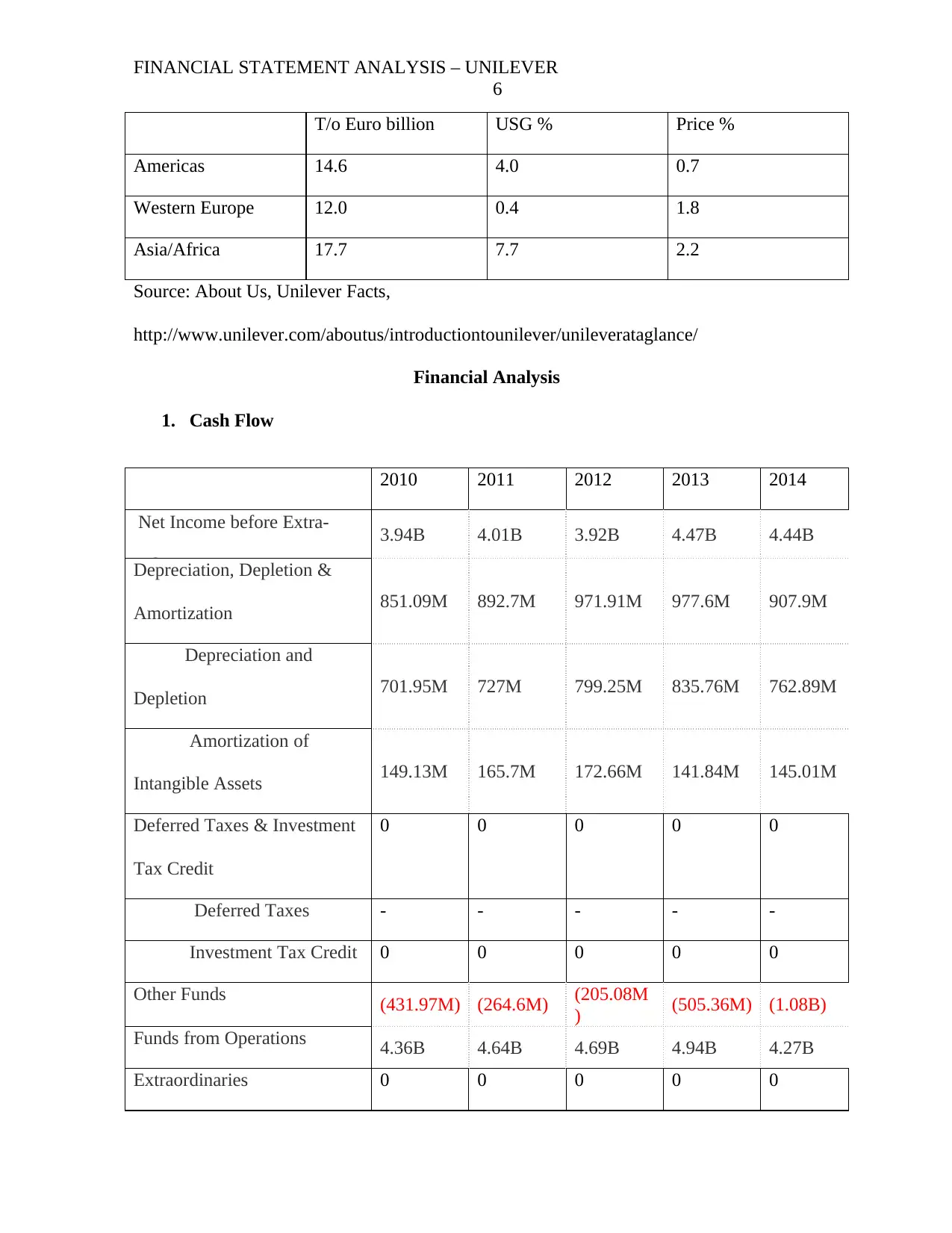
FINANCIAL STATEMENT ANALYSIS – UNILEVER
6
T/o Euro billion USG % Price %
Americas 14.6 4.0 0.7
Western Europe 12.0 0.4 1.8
Asia/Africa 17.7 7.7 2.2
Source: About Us, Unilever Facts,
http://www.unilever.com/aboutus/introductiontounilever/unileverataglance/
Financial Analysis
1. Cash Flow
2010 2011 2012 2013 2014
Net Income before Extra-
ordinaries
3.94B 4.01B 3.92B 4.47B 4.44B
Depreciation, Depletion &
Amortization 851.09M 892.7M 971.91M 977.6M 907.9M
Depreciation and
Depletion 701.95M 727M 799.25M 835.76M 762.89M
Amortization of
Intangible Assets 149.13M 165.7M 172.66M 141.84M 145.01M
Deferred Taxes & Investment
Tax Credit
0 0 0 0 0
Deferred Taxes - - - - -
Investment Tax Credit 0 0 0 0 0
Other Funds (431.97M) (264.6M) (205.08M
) (505.36M) (1.08B)
Funds from Operations 4.36B 4.64B 4.69B 4.94B 4.27B
Extraordinaries 0 0 0 0 0
6
T/o Euro billion USG % Price %
Americas 14.6 4.0 0.7
Western Europe 12.0 0.4 1.8
Asia/Africa 17.7 7.7 2.2
Source: About Us, Unilever Facts,
http://www.unilever.com/aboutus/introductiontounilever/unileverataglance/
Financial Analysis
1. Cash Flow
2010 2011 2012 2013 2014
Net Income before Extra-
ordinaries
3.94B 4.01B 3.92B 4.47B 4.44B
Depreciation, Depletion &
Amortization 851.09M 892.7M 971.91M 977.6M 907.9M
Depreciation and
Depletion 701.95M 727M 799.25M 835.76M 762.89M
Amortization of
Intangible Assets 149.13M 165.7M 172.66M 141.84M 145.01M
Deferred Taxes & Investment
Tax Credit
0 0 0 0 0
Deferred Taxes - - - - -
Investment Tax Credit 0 0 0 0 0
Other Funds (431.97M) (264.6M) (205.08M
) (505.36M) (1.08B)
Funds from Operations 4.36B 4.64B 4.69B 4.94B 4.27B
Extraordinaries 0 0 0 0 0
⊘ This is a preview!⊘
Do you want full access?
Subscribe today to unlock all pages.

Trusted by 1+ million students worldwide
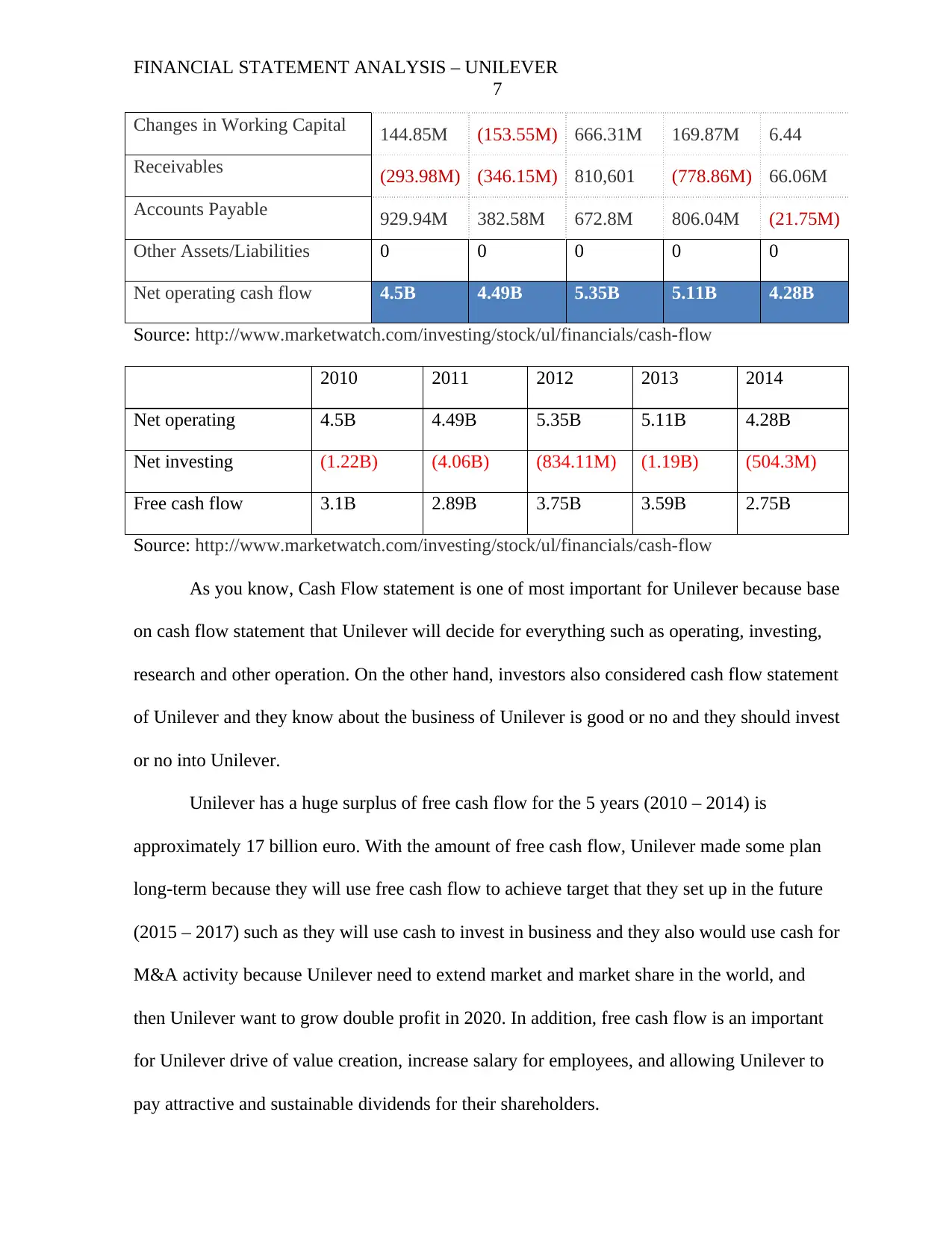
FINANCIAL STATEMENT ANALYSIS – UNILEVER
7
Changes in Working Capital 144.85M (153.55M) 666.31M 169.87M 6.44
Receivables (293.98M) (346.15M) 810,601 (778.86M) 66.06M
Accounts Payable 929.94M 382.58M 672.8M 806.04M (21.75M)
Other Assets/Liabilities 0 0 0 0 0
Net operating cash flow 4.5B 4.49B 5.35B 5.11B 4.28B
Source: http://www.marketwatch.com/investing/stock/ul/financials/cash-flow
2010 2011 2012 2013 2014
Net operating 4.5B 4.49B 5.35B 5.11B 4.28B
Net investing (1.22B) (4.06B) (834.11M) (1.19B) (504.3M)
Free cash flow 3.1B 2.89B 3.75B 3.59B 2.75B
Source: http://www.marketwatch.com/investing/stock/ul/financials/cash-flow
As you know, Cash Flow statement is one of most important for Unilever because base
on cash flow statement that Unilever will decide for everything such as operating, investing,
research and other operation. On the other hand, investors also considered cash flow statement
of Unilever and they know about the business of Unilever is good or no and they should invest
or no into Unilever.
Unilever has a huge surplus of free cash flow for the 5 years (2010 – 2014) is
approximately 17 billion euro. With the amount of free cash flow, Unilever made some plan
long-term because they will use free cash flow to achieve target that they set up in the future
(2015 – 2017) such as they will use cash to invest in business and they also would use cash for
M&A activity because Unilever need to extend market and market share in the world, and
then Unilever want to grow double profit in 2020. In addition, free cash flow is an important
for Unilever drive of value creation, increase salary for employees, and allowing Unilever to
pay attractive and sustainable dividends for their shareholders.
7
Changes in Working Capital 144.85M (153.55M) 666.31M 169.87M 6.44
Receivables (293.98M) (346.15M) 810,601 (778.86M) 66.06M
Accounts Payable 929.94M 382.58M 672.8M 806.04M (21.75M)
Other Assets/Liabilities 0 0 0 0 0
Net operating cash flow 4.5B 4.49B 5.35B 5.11B 4.28B
Source: http://www.marketwatch.com/investing/stock/ul/financials/cash-flow
2010 2011 2012 2013 2014
Net operating 4.5B 4.49B 5.35B 5.11B 4.28B
Net investing (1.22B) (4.06B) (834.11M) (1.19B) (504.3M)
Free cash flow 3.1B 2.89B 3.75B 3.59B 2.75B
Source: http://www.marketwatch.com/investing/stock/ul/financials/cash-flow
As you know, Cash Flow statement is one of most important for Unilever because base
on cash flow statement that Unilever will decide for everything such as operating, investing,
research and other operation. On the other hand, investors also considered cash flow statement
of Unilever and they know about the business of Unilever is good or no and they should invest
or no into Unilever.
Unilever has a huge surplus of free cash flow for the 5 years (2010 – 2014) is
approximately 17 billion euro. With the amount of free cash flow, Unilever made some plan
long-term because they will use free cash flow to achieve target that they set up in the future
(2015 – 2017) such as they will use cash to invest in business and they also would use cash for
M&A activity because Unilever need to extend market and market share in the world, and
then Unilever want to grow double profit in 2020. In addition, free cash flow is an important
for Unilever drive of value creation, increase salary for employees, and allowing Unilever to
pay attractive and sustainable dividends for their shareholders.
Paraphrase This Document
Need a fresh take? Get an instant paraphrase of this document with our AI Paraphraser
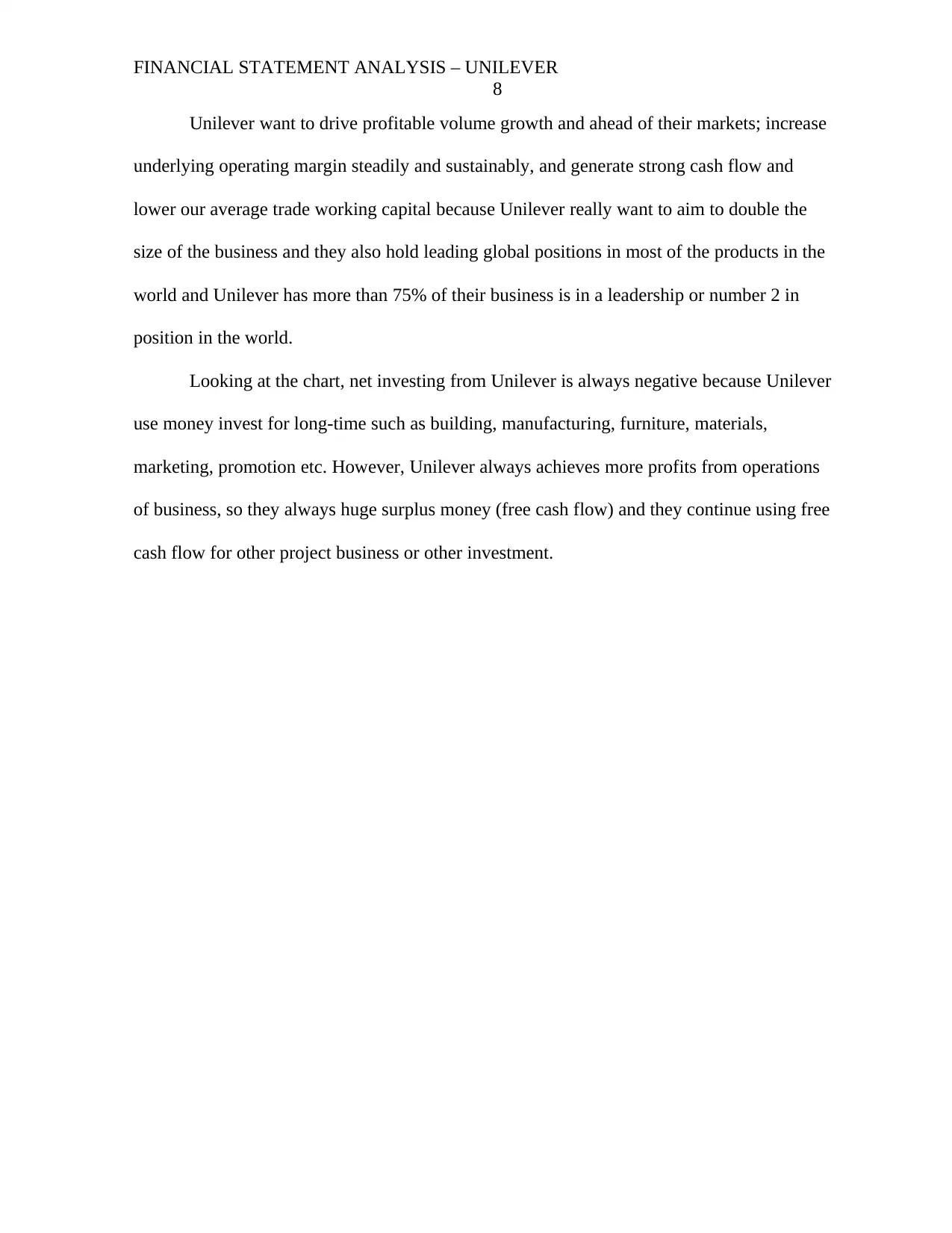
FINANCIAL STATEMENT ANALYSIS – UNILEVER
8
Unilever want to drive profitable volume growth and ahead of their markets; increase
underlying operating margin steadily and sustainably, and generate strong cash flow and
lower our average trade working capital because Unilever really want to aim to double the
size of the business and they also hold leading global positions in most of the products in the
world and Unilever has more than 75% of their business is in a leadership or number 2 in
position in the world.
Looking at the chart, net investing from Unilever is always negative because Unilever
use money invest for long-time such as building, manufacturing, furniture, materials,
marketing, promotion etc. However, Unilever always achieves more profits from operations
of business, so they always huge surplus money (free cash flow) and they continue using free
cash flow for other project business or other investment.
8
Unilever want to drive profitable volume growth and ahead of their markets; increase
underlying operating margin steadily and sustainably, and generate strong cash flow and
lower our average trade working capital because Unilever really want to aim to double the
size of the business and they also hold leading global positions in most of the products in the
world and Unilever has more than 75% of their business is in a leadership or number 2 in
position in the world.
Looking at the chart, net investing from Unilever is always negative because Unilever
use money invest for long-time such as building, manufacturing, furniture, materials,
marketing, promotion etc. However, Unilever always achieves more profits from operations
of business, so they always huge surplus money (free cash flow) and they continue using free
cash flow for other project business or other investment.
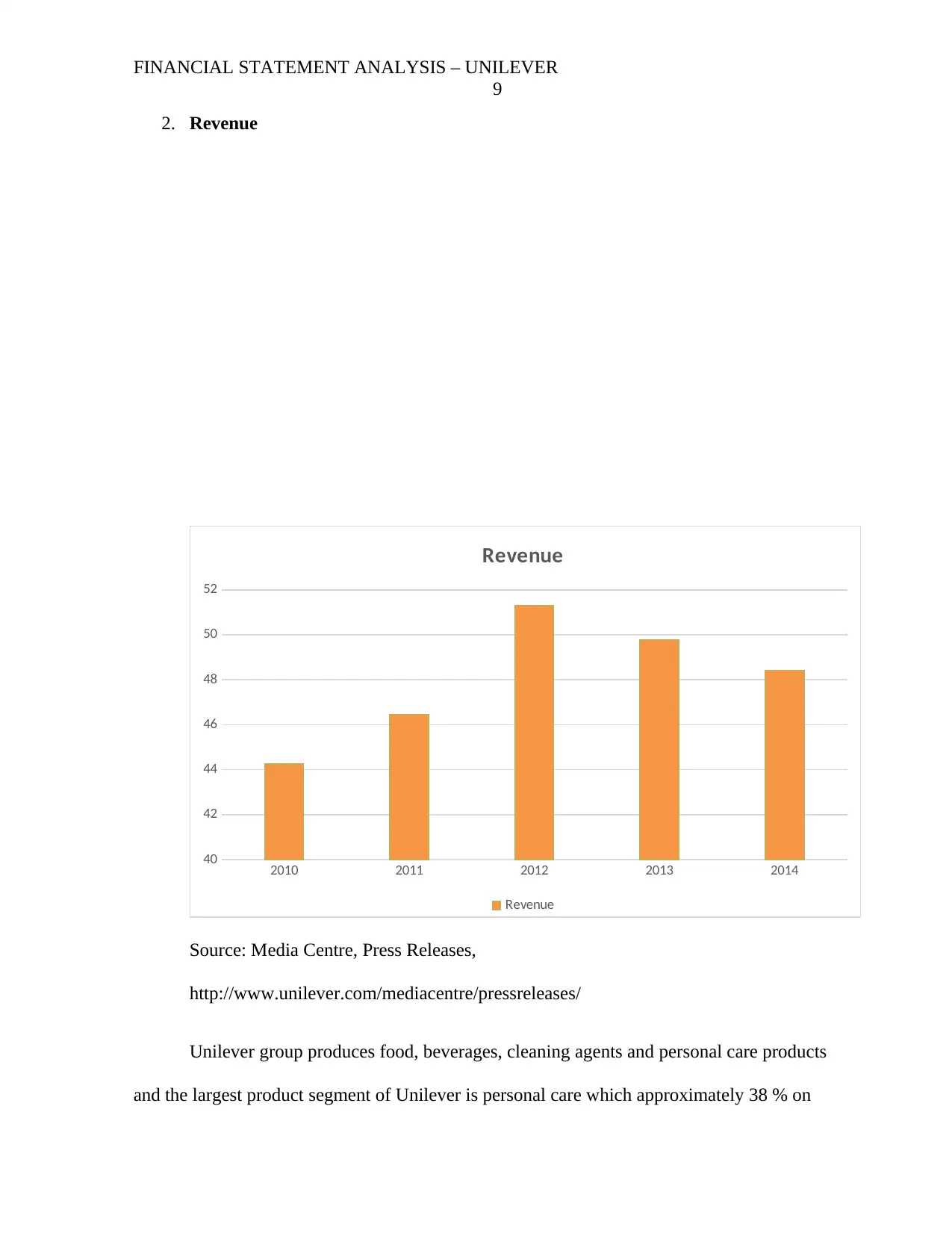
FINANCIAL STATEMENT ANALYSIS – UNILEVER
9
2. Revenue
2010 2011 2012 2013 2014
40
42
44
46
48
50
52
Revenue
Revenue
Source: Media Centre, Press Releases,
http://www.unilever.com/mediacentre/pressreleases/
Unilever group produces food, beverages, cleaning agents and personal care products
and the largest product segment of Unilever is personal care which approximately 38 % on
9
2. Revenue
2010 2011 2012 2013 2014
40
42
44
46
48
50
52
Revenue
Revenue
Source: Media Centre, Press Releases,
http://www.unilever.com/mediacentre/pressreleases/
Unilever group produces food, beverages, cleaning agents and personal care products
and the largest product segment of Unilever is personal care which approximately 38 % on
⊘ This is a preview!⊘
Do you want full access?
Subscribe today to unlock all pages.

Trusted by 1+ million students worldwide
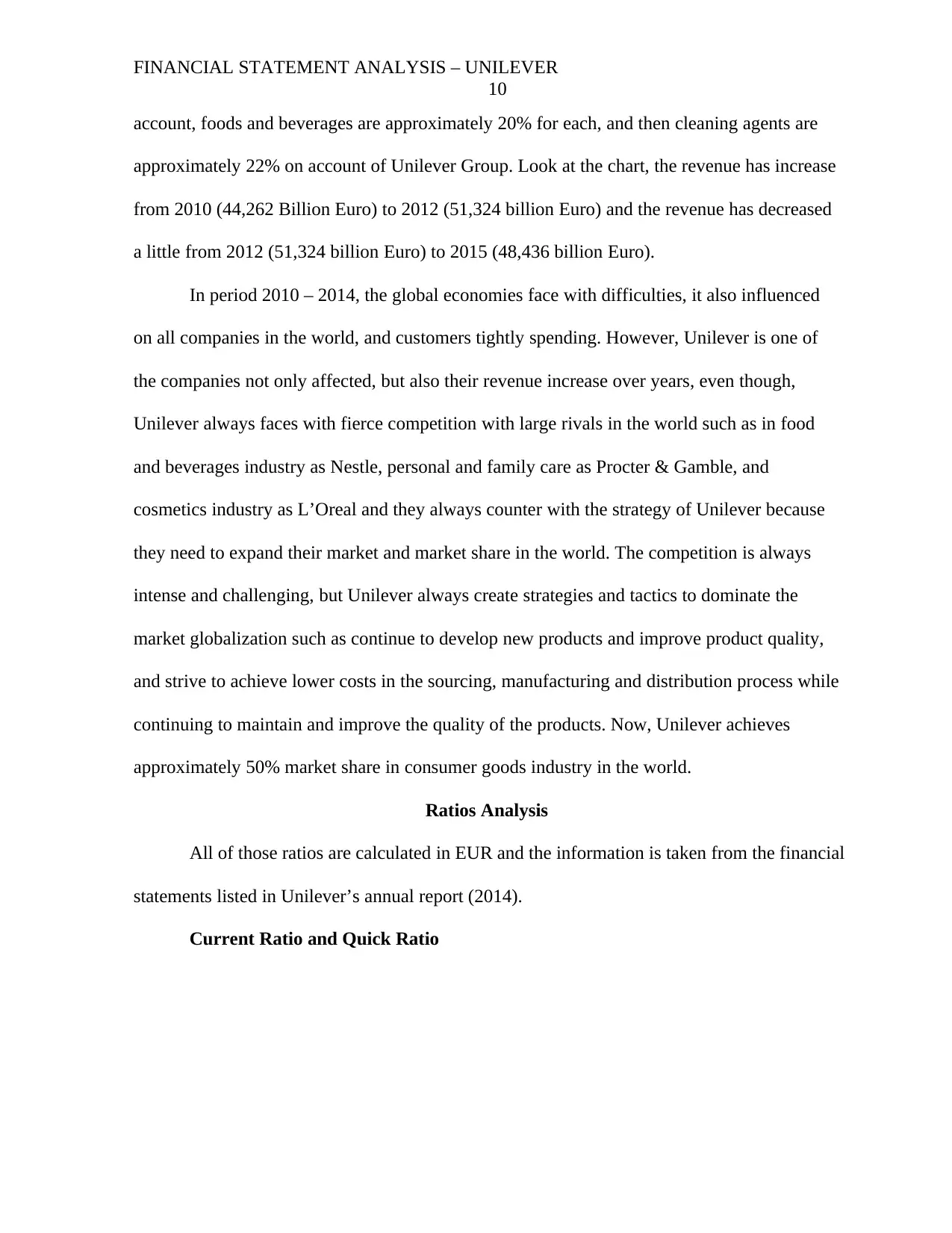
FINANCIAL STATEMENT ANALYSIS – UNILEVER
10
account, foods and beverages are approximately 20% for each, and then cleaning agents are
approximately 22% on account of Unilever Group. Look at the chart, the revenue has increase
from 2010 (44,262 Billion Euro) to 2012 (51,324 billion Euro) and the revenue has decreased
a little from 2012 (51,324 billion Euro) to 2015 (48,436 billion Euro).
In period 2010 – 2014, the global economies face with difficulties, it also influenced
on all companies in the world, and customers tightly spending. However, Unilever is one of
the companies not only affected, but also their revenue increase over years, even though,
Unilever always faces with fierce competition with large rivals in the world such as in food
and beverages industry as Nestle, personal and family care as Procter & Gamble, and
cosmetics industry as L’Oreal and they always counter with the strategy of Unilever because
they need to expand their market and market share in the world. The competition is always
intense and challenging, but Unilever always create strategies and tactics to dominate the
market globalization such as continue to develop new products and improve product quality,
and strive to achieve lower costs in the sourcing, manufacturing and distribution process while
continuing to maintain and improve the quality of the products. Now, Unilever achieves
approximately 50% market share in consumer goods industry in the world.
Ratios Analysis
All of those ratios are calculated in EUR and the information is taken from the financial
statements listed in Unilever’s annual report (2014).
Current Ratio and Quick Ratio
10
account, foods and beverages are approximately 20% for each, and then cleaning agents are
approximately 22% on account of Unilever Group. Look at the chart, the revenue has increase
from 2010 (44,262 Billion Euro) to 2012 (51,324 billion Euro) and the revenue has decreased
a little from 2012 (51,324 billion Euro) to 2015 (48,436 billion Euro).
In period 2010 – 2014, the global economies face with difficulties, it also influenced
on all companies in the world, and customers tightly spending. However, Unilever is one of
the companies not only affected, but also their revenue increase over years, even though,
Unilever always faces with fierce competition with large rivals in the world such as in food
and beverages industry as Nestle, personal and family care as Procter & Gamble, and
cosmetics industry as L’Oreal and they always counter with the strategy of Unilever because
they need to expand their market and market share in the world. The competition is always
intense and challenging, but Unilever always create strategies and tactics to dominate the
market globalization such as continue to develop new products and improve product quality,
and strive to achieve lower costs in the sourcing, manufacturing and distribution process while
continuing to maintain and improve the quality of the products. Now, Unilever achieves
approximately 50% market share in consumer goods industry in the world.
Ratios Analysis
All of those ratios are calculated in EUR and the information is taken from the financial
statements listed in Unilever’s annual report (2014).
Current Ratio and Quick Ratio
Paraphrase This Document
Need a fresh take? Get an instant paraphrase of this document with our AI Paraphraser
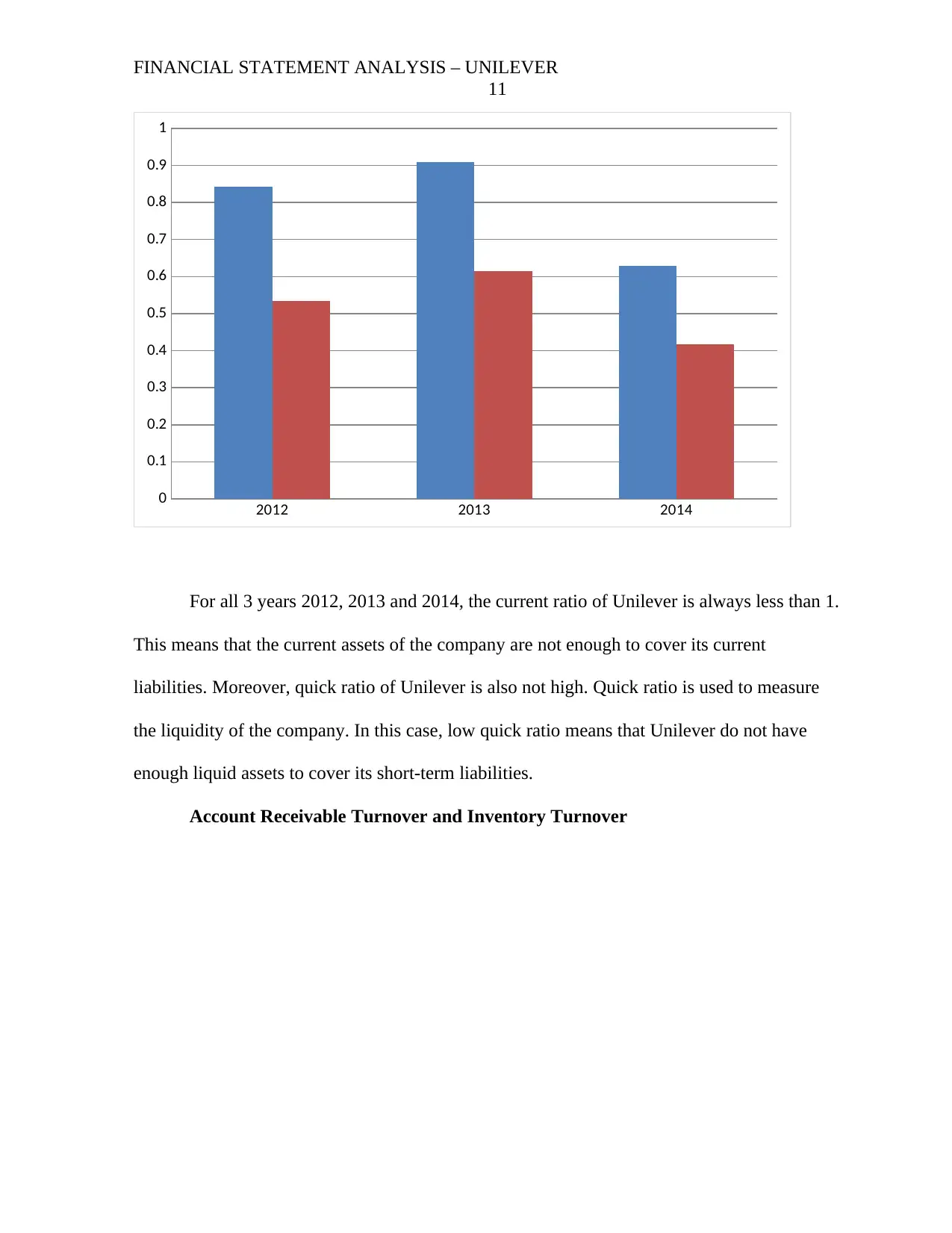
FINANCIAL STATEMENT ANALYSIS – UNILEVER
11
2012 2013 2014
0
0.1
0.2
0.3
0.4
0.5
0.6
0.7
0.8
0.9
1
For all 3 years 2012, 2013 and 2014, the current ratio of Unilever is always less than 1.
This means that the current assets of the company are not enough to cover its current
liabilities. Moreover, quick ratio of Unilever is also not high. Quick ratio is used to measure
the liquidity of the company. In this case, low quick ratio means that Unilever do not have
enough liquid assets to cover its short-term liabilities.
Account Receivable Turnover and Inventory Turnover
11
2012 2013 2014
0
0.1
0.2
0.3
0.4
0.5
0.6
0.7
0.8
0.9
1
For all 3 years 2012, 2013 and 2014, the current ratio of Unilever is always less than 1.
This means that the current assets of the company are not enough to cover its current
liabilities. Moreover, quick ratio of Unilever is also not high. Quick ratio is used to measure
the liquidity of the company. In this case, low quick ratio means that Unilever do not have
enough liquid assets to cover its short-term liabilities.
Account Receivable Turnover and Inventory Turnover
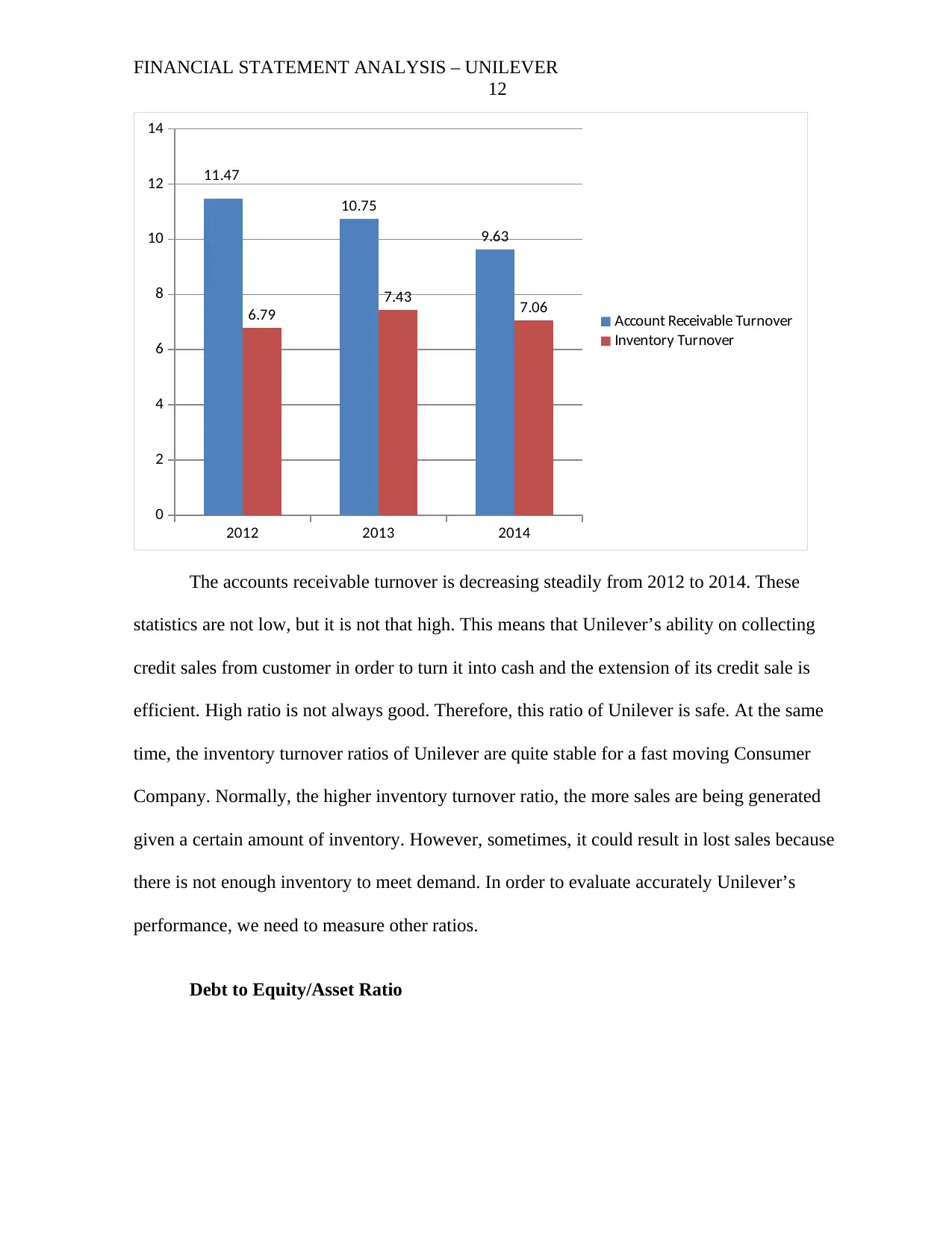
FINANCIAL STATEMENT ANALYSIS – UNILEVER
12
2012 2013 2014
0
2
4
6
8
10
12
14
11.47
10.75
9.63
6.79
7.43 7.06 Account Receivable Turnover
Inventory Turnover
The accounts receivable turnover is decreasing steadily from 2012 to 2014. These
statistics are not low, but it is not that high. This means that Unilever’s ability on collecting
credit sales from customer in order to turn it into cash and the extension of its credit sale is
efficient. High ratio is not always good. Therefore, this ratio of Unilever is safe. At the same
time, the inventory turnover ratios of Unilever are quite stable for a fast moving Consumer
Company. Normally, the higher inventory turnover ratio, the more sales are being generated
given a certain amount of inventory. However, sometimes, it could result in lost sales because
there is not enough inventory to meet demand. In order to evaluate accurately Unilever’s
performance, we need to measure other ratios.
Debt to Equity/Asset Ratio
12
2012 2013 2014
0
2
4
6
8
10
12
14
11.47
10.75
9.63
6.79
7.43 7.06 Account Receivable Turnover
Inventory Turnover
The accounts receivable turnover is decreasing steadily from 2012 to 2014. These
statistics are not low, but it is not that high. This means that Unilever’s ability on collecting
credit sales from customer in order to turn it into cash and the extension of its credit sale is
efficient. High ratio is not always good. Therefore, this ratio of Unilever is safe. At the same
time, the inventory turnover ratios of Unilever are quite stable for a fast moving Consumer
Company. Normally, the higher inventory turnover ratio, the more sales are being generated
given a certain amount of inventory. However, sometimes, it could result in lost sales because
there is not enough inventory to meet demand. In order to evaluate accurately Unilever’s
performance, we need to measure other ratios.
Debt to Equity/Asset Ratio
⊘ This is a preview!⊘
Do you want full access?
Subscribe today to unlock all pages.

Trusted by 1+ million students worldwide
1 out of 20
Related Documents
Your All-in-One AI-Powered Toolkit for Academic Success.
+13062052269
info@desklib.com
Available 24*7 on WhatsApp / Email
![[object Object]](/_next/static/media/star-bottom.7253800d.svg)
Unlock your academic potential
Copyright © 2020–2025 A2Z Services. All Rights Reserved. Developed and managed by ZUCOL.





